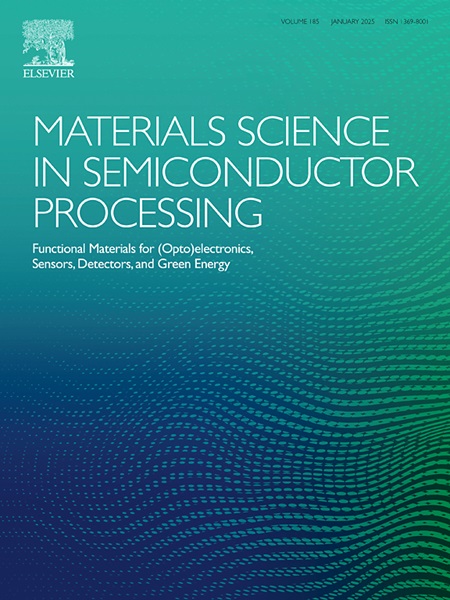全面分析立方 Ca3SbX3(X = Cl、Br)的结构、声子、电子、机械、光学和热物理性质:DFT - GGA 和 mBJ 研究
IF 4.6
3区 工程技术
Q2 ENGINEERING, ELECTRICAL & ELECTRONIC
引用次数: 0
摘要
目前的研究采用了第一原理计算方法来评估无铅立方体 Ca3SbX3(X = Cl、Br)的结构、声子、机械、电子、光学、热力学和热电特性。通过分析声子频散谱,评估了这两种化合物的动态稳定性。在施加压力时,原子间的距离明显缩小,导致 Ca3SbX3(X = Cl,Br)化合物的键长、晶胞体积和晶格常数大幅下降。在 0 GPa 压力下,通过 mBJ 函数,Ca3SbCl3 和 Ca3SbBr3 化合物的直接带隙 (Γ-Γ) 分别为 2.57 和 2.27 eV;通过 GGA 函数,分别为 1.82 和 1.34 eV。此外,在考虑自旋轨道耦合 (SOC) 的量子效应时,Ca3SbCl3 和 Ca3SbBr3 的带隙分别降至 1.65 eV 和 1.45 eV。当压力水平上升到 30 GPa 时,通过 mBJ 函数,Ca3SbCl3 和 Ca3SbBr3 化合物的带隙分别减小到 0.89 和 0.65 eV;通过 GGA 函数,分别减小到 0.27 和 0.12 eV。增加压力可降低有效质量,从而提高两种电荷载流子的导电性。重组率的降低表明这两种化合物具有更强的吸收能力,因此更适合用作太阳能吸收剂。机械性能分析表明,随着压力的增加,弹性模量上升,材料从脆性过渡到韧性。此外,由于带隙的改变,这两种材料在高压下的吸收率和光导率都发生了重移,介电常数得到改善,更适合用于手术器械和太阳能吸收器。热力学特性显示了它们的耐温性和对高温的适应性。最后,它们的热电性能评估表明,它们具有较高的 PF 值和接近统一的 ZT 值,这表明它们可用于热电设备。本文章由计算机程序翻译,如有差异,请以英文原文为准。
A comprehensive analysis of the structural, phonon, electronic, mechanical, optical, and thermophysical properties of cubic Ca3SbX3 (X = Cl, Br): DFT - GGA and mBJ studies
The current investigation employed first-principles calculation to assess the structural, phonon, mechanical, electronic, optical, thermodynamic, and thermoelectric properties of lead-free cubic Ca3SbX3 (X = Cl, Br). The dynamic stability of both compounds is assessed by analyzing the phonon dispersion spectrum. The distance between atoms is significantly reduced, leading to a large drop in the bond length, cell volume, and lattice constant of Ca3SbX3 (X = Cl, Br) compounds upon applying pressure. Ca3SbCl3 and Ca3SbBr3 compounds have direct bandgaps (Γ-Γ) of 2.57 and 2.27 eV via mBJ functional and 1.82 and 1.34 eV via GGA functional at 0 GPa pressure. Additionally, the bandgaps of Ca3SbCl3 and Ca3SbBr3 decrease to 1.65 eV and 1.45 eV, respectively, when accounting for the quantum effects of spin-orbit coupling (SOC). As the level of pressure rises to 30 GPa, Ca3SbCl3 and Ca3SbBr3 compound's band gaps reduce to 0.89 and 0.65 eV via mBJ functional and 0.27 and 0.12 via GGA functional. Increasing pressure is shown to reduce the effective mass, thereby enhancing the conductivity of both types of charge carriers. The reduced recombination rate signifies both compounds' greater absorption capabilities, making them more suitable for solar absorbers. The analysis of the mechanical properties indicates that as pressure increases, the elastic moduli rise, and the material transitions from being brittle to becoming more ductile. Additionally, both materials show a redshift of absorption and optical conductivity with improved dielectric constants at high pressure owing to the alteration in the bandgap, which is more appropriate for surgical instruments and solar absorbers. Thermodynamic properties show their temperature tolerance and appropriateness for high temperatures. Lastly, their thermoelectric property evaluation indicates high PF and near unity ZT, suggesting their use in thermoelectric devices.
求助全文
通过发布文献求助,成功后即可免费获取论文全文。
去求助
来源期刊

Materials Science in Semiconductor Processing
工程技术-材料科学:综合
CiteScore
8.00
自引率
4.90%
发文量
780
审稿时长
42 days
期刊介绍:
Materials Science in Semiconductor Processing provides a unique forum for the discussion of novel processing, applications and theoretical studies of functional materials and devices for (opto)electronics, sensors, detectors, biotechnology and green energy.
Each issue will aim to provide a snapshot of current insights, new achievements, breakthroughs and future trends in such diverse fields as microelectronics, energy conversion and storage, communications, biotechnology, (photo)catalysis, nano- and thin-film technology, hybrid and composite materials, chemical processing, vapor-phase deposition, device fabrication, and modelling, which are the backbone of advanced semiconductor processing and applications.
Coverage will include: advanced lithography for submicron devices; etching and related topics; ion implantation; damage evolution and related issues; plasma and thermal CVD; rapid thermal processing; advanced metallization and interconnect schemes; thin dielectric layers, oxidation; sol-gel processing; chemical bath and (electro)chemical deposition; compound semiconductor processing; new non-oxide materials and their applications; (macro)molecular and hybrid materials; molecular dynamics, ab-initio methods, Monte Carlo, etc.; new materials and processes for discrete and integrated circuits; magnetic materials and spintronics; heterostructures and quantum devices; engineering of the electrical and optical properties of semiconductors; crystal growth mechanisms; reliability, defect density, intrinsic impurities and defects.
 求助内容:
求助内容: 应助结果提醒方式:
应助结果提醒方式:


